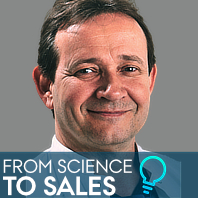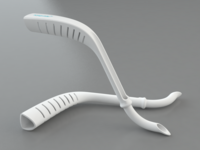- Education
-
Research
Current research
Talent
-
Collaboration
Businesses
Government agencies and institutions
Alumni
-
About AU
Organisation
Job at AU
"Just do it! Working on inventions is instructive and fun” is the advice from Consultant, PhD Niels Katballe. As a surgeon and clinical researcher, he has taken the step from publishing articles about inserting drains to actually developing a pulmonary surgical instrument that will now be marketed from the United States.
2018.10.04 |

Don’t do it alone! Find one or more business partners so you can share the tasks sensibly, is an important piece of advice from Niels Katballe. Photo: Aarhus University Hospital.

This is what the pulmonary surgical instrument KatGuide looks like. It has been developed by Consultant Niels Katballe in collaboration with Engineer Peter Heydorn and out-licensed to an American company. Photo: Aarhus University Hospital.
"Your eyes begin to glaze over a bit when you’re asked to present your business plan and its timesheet. And when you start getting questions about what your market analysis says."
With both a shake of the head and a chuckle, cardio-vascular surgeon Niels Katballe recalls his first meeting with a world that is miles away from the one in which he usually works, which revolves around life and death in the operating theatre and the occasional publication of own research. Yet, it has been meaningful and satisfying to make the leap as an inventor, stresses Katballe, who normally works as a consultant at Aarhus University Hospital and also for a number of years as clinical associate professor at the Department of Clinical Medicine:
"It's so satisfying to be involved in the commercialisation of an instrument that you yourself have stood and wished you had in the operating theatre," he says. The invention is a pulmonary surgical instrument called KatGuide, which has been developed in collaboration with Engineer Peter Heydorn and out-licensed for tens of millions of the American company Merit Medical Systems, who will now launch the patented instrument on the world market.
"Nine years have passed since I had the idea and since then Peter Heydorn and I have invested thousands of hours in working on KatGuide. On the other hand, as a consultant and researcher I’ve had the chance to get involved in a completely different world and way of thinking, and I’ve learned so much from it," says Katballe.
The idea for KatGuide was conceived in 2009, when Katballe first noticed that many surgical drains – in medical language called pleural drains – were not optimally placed in the lung cavity of the patients undergoing surgery. The drains are typically inserted in the hospital emergency wards to remove either air or liquid from the lung cavity, and inserting them is no easy manoeuvre, explains Katballe.
"The drain must point upwards if it is to remove air from the lungs, but downwards if you need to drain liquid. I therefore began to speculate about whether it was possible to develop a ‘guide' in the form of a plastic tube that could lead the lung drain into the pleural cavity and help place it exactly where it should be," explains Katballe.
With this idea in mind, he sat down at the drawing board together with his old friend and engineer Peter Heydorn, who had once mentioned the idea that perhaps they could one day do something together: From there, one thing led to another.
The first practical step was to visit the DIY store and buy a swivel spout for a faucet. After some sawing and filing into the shape that Katballe had in mind, it was taken to the research basement at the Department of Clinical Medicine and tested on a dead pig. The adapted swivel spout was the pioneer for several prototypes made from different materials that were tested over the following years. Initially in a pilot project in which six medical doctors and medical students inserted the drain using KatGuide version 2.0 (now made from electrical cabling) into a deceased test subject, where KatGuide appeared to function as intended.
The next step was an actual randomised study, during which KatGuide was tested and compared with the conventional method where medical doctors use pliers to place the drain into the lung cavity – in medical terminology called the Pean method. The randomised controlled trial involved 109 patients from the cardiothoracic and vascular surgery departments in Aarhus, Odense and Aalborg, and in 2015 Niels Katballe showed in a peer-reviewed research article in the American journal Annals of Thoracic Surgery that a total of 84 per cent of the drains were inserted correctly with the KatGuide method, as against only 53 per cent using the Pean method.
"There’s no doubt that the trial attracted the American’s interest, but it takes an incredibly long time to finally get an invention out there," says Katballe.
"From the publication in 2015, it took two years to develop KatGuide in the company Pleuratech which Peter Heydorn and I founded for this purpose. Of course, with a view to divesting the task to someone who can produce, market and distribute KatGuide, for it was never part of the plan to become manufacturers here in Djursland," says Katballe. He explains that the development has taken place in collaboration with Pleuratech’s three co-owners, who are Aarhus University, the Central Denmark Region and the government-owned innovation environment CAPNOVA, who have invested venture capital in new innovative companies over a number of years. CAPNOVA is currently being phased out on the basis of a government decision with support from the Danish People's Party.
"It’s truly regrettable, because CAPNOVA – or East-Jutland Innovation as it was called when we started – has provided a unique opportunity to both get expert advice and borrow some of the millions which a development project most often costs. We’ve borrowed money at a relatively high interest rate, but with the invaluable security of knowing that the money would not have to be repaid if the project failed," says Niels Katballe, who also highlights the central Denmark Region’s MedTech Innovation Consortium (MTIC), who contributed with invaluable guidance on how to get started and how to negotiate the legal jungle.
"It cannot be said clearly enough how crucial it was to be able to draw on the right professionals and to get help with e.g. patent rules and finding certified manufacturers of the plastic we’ve used. If I’d been alone with these tasks as a medical doctor, I would have dropped the whole project several years ago," says Katballe, before providing some well-intentioned collegial advice to other researchers who want to follow the inventor path:
“Don’t do it alone! Find one or more business partners so you can share the tasks sensibly. In Peter's and my case, it was obvious that I should take care of the medical side of things, including the randomised trials and approvals, risk assessments, user guides, presentation of the project and the like, while as an engineer, Peter has dealt with the technical challenges, business relations, accounts, patents and convening board meetings and that kind of thing. And seen in hindsight, this set-up has just worked," says Niels Katballe today.
The current status of the project is that the American company are working on the production and marketing strategy that intends to put KatGuide onto the shelves of medical equipment distributors all over the world. The cost of the product is not something that Niels Katballe and Peter Heydorn have any influence on, as Merit Medical Systems alone determine this.
"Naturally, I'm anxious to find out whether KatGuide will be sold cheaply to the many, or as an expensive product for the few," says Katballe, who guesses that the production price is around five US dollars per guide.
"On the other hand, this is a theoretical isolated price, because the fact is that millions of Danish kroner and US dollars, plus a lot of working hours and a great deal of my and Peter’s spare time – evenings, weekends and holidays – have all been invested in this over the last eight years. And if I’ve learned anything from going down the commercial road, it’s that business shouldn’t be confused with philanthropy," he says.
Here and now, he is pleased to see that KatGuide is recommended instead of the Pean method in the third edition of the leading American textbook Emergency Medicine Procedures, which will be published in December. Because as he says, textbooks have more influence on clinical practice than many research publications.
"And of course, I hope that I will soon be able to buy my own invention and use it in the operating theatre. I still have a prototype version in my office, but according to the rules, I’m not allowed to use the instrument before it is available on the market, so I’m looking forward to that," says Katballe.
Consultant, Clinical Associate Professor, PhD, Niels Katballe
Aarhus University, Department of Clinical Medicine and
Aarhus University Hospital, Department of Cardiothoracic and Vascular Surgery
Email: Niels.Katballe@skejby.rm.dk
Mobile: (+45) 6168 3931